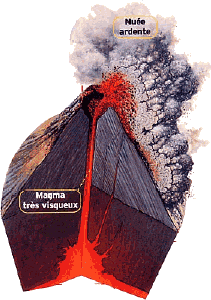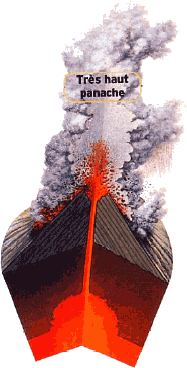|
IMPACTS
OF VOLCANOES ON CLIMATE |
3st
PART
Volcanologists distinguish six major types of eruptions.
Below you have the types of eruptions in order of increasing
intensity. An index of the power of volcanoes, the "VEI"
(In English, "Volcanic Explosivity"), was imagined
by Chris Newhall. This scale is multiplied by 10 when passing
for example from VEI 1 to 2. So an eruption of VEI 8 is 10 million
times more powerful than eruption of VEI 1.
Ejection volume, size of the cloud of the eruption, ...
are factors for the VEI measure. The scale ranges from 0, for
inexplosive eruptions (less than 104
m3 of ejected
tephra), to 8 for the explosive eruptions of great intensity
which can eject up to 1012
m3 and a cloud column over 25 km height). The values
higher than 8 could be determined if necessary.
- Hawaiian
kind :
"Hawaiian" volcano eruptions have a very
fluid lava, it gushes into fountains to tens or hundreds
of meters high, it flows over long distances, or it
boils in a lava lake.
The name of this type of eruption comes from volcanoes
of the Hawaiian Islands. The "shield volcanoes"
that emit them have low altitude compared to their
diameter (with a slope of 5%). Their activity is effusive.
Volcano eruption of this type is Mauna Loa, Hawaii,
which lies at the bottom of the ocean to 5000 meters
deep and its crater is 4171 meters high above the
ocean. It is the highest volcano. We also have Kilauea
in Hawaii, the Piton de la Fournaise on the island
of Reunion, The Trölladyngja in Iceland...
|
Hawaiian type - VEI : from 0 to 1
|
|
|

Strombolian type - VEI : from 1 to 2
|
|
- Pelean
type :
The magma of these volcanoes is very viscous. Pelean
eruptions of lava are thick and pasty. They completely
solidify on contact with air. Forming a very resistant
cap at the exit of the chimney, the gases trapped
below push it and do it rise up by constructing slowly
a lava dome. Heavy clouds of gas, ash and incandescent
blocks, named fiery clouds, occasionally escape from
the dome cracks and slide down the slopes. When the
pressure is at maximum an explosion occurred, shattering
the dome and leaving violently escape the lava.
This category takes its name from the eruption of
Mount Pelee 1902-1904, famous volcano in Martinique.
As this type of volcano eruption we also Lamington
in New Guinea, the Puy de Dôme in the Massif
Central, asleep from about 11,000
years, the Soufriere in Guadeloupe, sometimes the
Vesuvius in southern Italy...
|

Pelean type - VEI : from 1 to 8
|
-
Plinian
type :
These flares are the most violents.
The magma of these volcanoes is thick and pasty.
Their eruptions are characterized by very violent
explosions the open crater projecting a large
plume of ash and pumice (less dense than air)
at altitudes of 10-20 km in the form of umbrella
pine tree (to distinguish from the fiery cloud)
. Upon reaching the atmosphere, the gases trapped
in the magma expand and give birth to whitish
ash. These eruptions are less frequent than the
others but do much more damage and casualties.
The name of this type of eruption comes from Pliny
who described the eruption of Vesuvius in 79 AD.
As volcano with plinian eruption there are Mount
St. Helens in the US which has experienced a rash
to this type in 1980, the Santorini in Greece,
the Pinatubo in the Philippines, Mount Pelee sometimes,...
|

Plinian type - VEI : from 4 to 8
|
- The
types of submarine eruptions :
The types of submarine eruptions are classified
into two families of eruptions that are produced by
the meeting of water and magma.
- Surtseyan
type :
This type of eruption is a sub type of Hawaiian
eruptions for shallow submarine eruptions. They
are particularly explosive due to contact with
water and larva, forming a column rich in water
vapor, horizontal and radial clouds. Volcanic
islands often born after several surtseyennes
eruptions.
The name of this type of eruption comes from Surtsey
in south of Iceland, which erupted in 1963. As
with this type of volcano eruption there are Ambrym,
Mont Saint-Loup Cap d'Agde...
- Under-water
type :
This type of eruption is characterized by the
emission of lava under a body of water. When the
lava comes into contact with the water while it
is covered with a thin layer of hardened lava
fracturing under the pressure of the liquid still
lava, then giving birth to cushion lava. Then
the water warms at contact with the lava and when
the water pressure is low enough, it vaporizes
and can back up to the surface forming a volcanic
plume formed mainly of water vapour.
|

Type surtseyen - VEI : from 2 to
5
|
- Vulcanian
type :
The volcanoes of this type are made of very thick
and very viscous lava which block the volcanic chimney.
Then an explosion occurs when the pressure is at
maximum by pulverizing the lava that gushes into
the sky. Up to a height that can reach 25 km, blocks
of several tons and microscopic ashes are projected
by the eruption. Often a huge explosion makes blow
up the crater and created a large depression from
where born a new volcanic system.
The name of this type comes from an Italian volcano
in the Aeolian islands, called Vulcano. As vulcanian
volcano there is also the Fuego in Guatemala it
last erupted was in October 1974, Sakurajima in
Japan...
|

Vulcanian type - VEI : from 2 to
5
|
|
VEI
|
Classification
|
Description
|
height
of smoke
|
Ejected
volume
|
Frequency
of eruptions
|
Exemple
|
Total
historical eruptions from 1994
|
|
0
|
Hawaiian
|
non-explosif
|
< 100 m
|
> 1000 m³
|
frequent
|
|
-
|
|
1
|
Hawaiian /
Strombolian
|
small
|
100-1000 m
|
> 10,000 m³
|
frequent
|
|
-
|
|
2
|
Strombolian /
Vulcanian
|
explosif
|
1-5 km
|
> 1,000,000 m³
|
each week
|
Galeras
in 1992
|
3477
|
|
3
|
Vulcanian
|
severe
|
3-15 km
|
> 10,000,000 m³
|
annually
|
1985...
|
868
|
|
4
|
Vulcanian /
Plinian
|
cataclysmic
|
10-25 km
|
> 0.1 km³
|
10 years
|
1982
|
278
|
|
5
|
Plinian
|
paroxysmal
|
> 25 km
|
> 1 km³
|
100 years
|
1980
|
84
|
|
6
|
Plinian /
Ultra-Plinian
|
colossal
|
> 25 km
|
> 10 km³
|
100 years
|
Krakatau
in 1883
|
39
|
|
7
|
Ultra-Plinian
|
super-colossal
|
> 25 km
|
> 100 km³
|
1000 years
|
Tambora
in 1815
|
4
|
|
8
|
Ultra-Plinian
|
mega-colossal
|
> 25 km
|
> 1000 km³
|
10,000
ans
|
Toba eruption
75 000 years ago
|
1
|

.gif) WARNING
WARNING
Patricia
Régnier helped me correct mistakes, please you to
visit her
blog
I’m not english speaker, some improprieties can appear
to english masters.
Could you help me reporting by mail any fault you read.
Thank you for all.
Contact :
|







